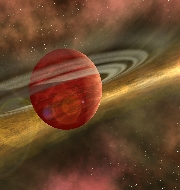Scientists discover Super Earth like exoplanet GJ 536b
Scientists have discovered a new ‘super Earth’ type exoplanet named as GJ 536b orbiting a very bright star near to our Sun.
The planet was jointly detected by Instituto de Astrofisica de Canarias (IAC) and the Geneva Observatory.
Key Facts
- The exoplanet GJ 536b has a mass of around 5.4 Earth masses. It is orbiting a star much smaller and cooler than the sun
- It is not within the star’s habitable zone and has short orbital period of 8.7 day. The luminosity of its star makes it an attractive candidate for investigating its atmospheric composition.
- Besides, the planet’s short orbital period would come handy in conducting future studies of biological activity.
How GJ 536b was discovered?
It was detected using the HARPS (High Accuracy Radial velocity Planet Seeker) spectrograph on the 3.6M ESO Telescope (La Silla in Chile) and HARPS North on the Telescopio Nacional Galileo (TNG) Roque de los Muchachos Observatory (Garafia in Spain). HARPS is a second-generation high-precision radial velocity planet finding spectrograph. It is the most successful planet finder after the Kepler Space Observatory
Astronomical terms
- Exoplanet: It is a planet that does not orbit the Sun and instead orbits a different star, stellar remnant, or brown dwarf. It is also termed as extrasolar planet.
- Super-earths: They are extrasolar planets which are larger than the Earth. However they have mass substantially below the solar system’s giant planets namely Neptune and Uranus.
Month: Current Affairs - November, 2016


